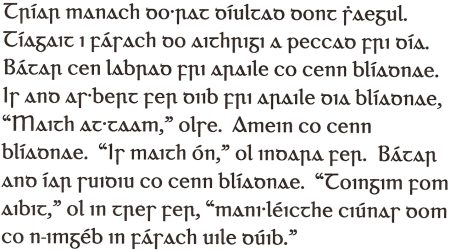 They went “do aithrigi a peccad”, that is, “for penance / penitence / repentence / repenting of their sins”. The word “aithrige” (dative “aithrigi”) is the verbal noun of the Old Irish verb “ad·eirreig”, which had two somewhat different meanings: (1) repeats, and (2) changes. The latter meaning was extended to include “changes for the better; improves”.
They went “do aithrigi a peccad”, that is, “for penance / penitence / repentence / repenting of their sins”. The word “aithrige” (dative “aithrigi”) is the verbal noun of the Old Irish verb “ad·eirreig”, which had two somewhat different meanings: (1) repeats, and (2) changes. The latter meaning was extended to include “changes for the better; improves”.The verbal noun “aithrige” takes the idea of “changing for the better” one step further so that it ends up implying a change of attitude, and thereby an attempt to undo, repair, rectify a mistake.
Interestingly, the Old Irish verb “ad·eirreig” bifurcates during the history of the language, so that today in Modern Irish we have both:
1) “athraigh = changes” and its verbal noun “athrú = changing, change”; and
2) “aithrí = penance; repentence”.
In any case, the Three Monks apparently went into the wilderness in order to undo their sins before God by doing penance, not in order to repeat them!
















